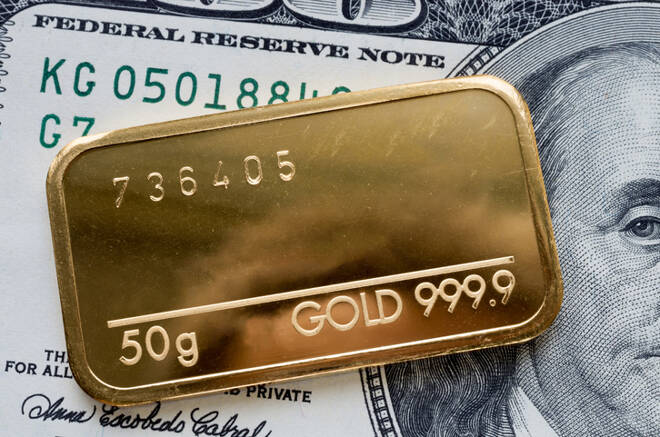Advertisement
Advertisement
Gold – Not So Precious
Published: Apr 19, 2021, 06:41 GMT+00:00
Which one should we buy – gold, bonds, or metals? Which one is likely to give the best return, say, over the next 1-2 years? Not a simple decision. Especially when one considers the buy decision must be associated with the sell decision.
Summary
Three different assets: gold, bonds, and metals.
There is a significant relationship between them.
Which one is the best investment depends on the phase of the business cycle?
This article is about the relationships between the three so different assets – when to buy them and when to sell them.
The business cycle is what drives the relative attractiveness of these three investments. And the business cycle is driven by business decisions to keep inventories at levels needed to meet demand and generate a profit.
The dynamics of the decision-making process is not simple. In fact, it is so difficult, mistakes are made. These mistakes cause turning points in the business cycles, and these turning points create unique opportunities for investors.
In Phase 2 (see above chart) the business cycle reflects a strengthening and overheating economy. Business is focusing on replenishing inventories because of strong demand. Purchases of raw materials, hiring of workers, and borrowing to finance capital improvement and expansion are fast-growing activities. For this reason, in this phase investors experience rising commodities, strong growth in employment and wages, and increasing inflation and interest rates.
In Phase 3 business ignores the fact inflation is rising in an alarming way. The outcome is purchasing power decreases and demand slows down. But business believes this weaker demand is a transitory event and decides to keep production humming to keep unit costs low.
Earnings, however, start declining as inventory levels increase to high levels when compared to demand. The decision is eventually made to cut inventories thus signaling the beginning of Phase 3.
The business cycle will have reached the end of Phase 4 when inventories are cut enough to re-establish profitability. Meanwhile, commodities, interest rates, and inflation have declined enough to restore consumers’ purchasing power.
Production will have to increase again to restock depleted inventories by hiring new workers. Commodities and interest rates stop declining while inflation may keep heading lower. Phase 1 is now underway.
The increase in demand, due to the improvement in purchasing power, forces businesses to add to inventories, eventually placing upward pressure on commodities, inflation, and interest rates. The business cycle is now again in Phase 2.
Where do we stand now as of this writing? Inflation is rising rapidly. Commodities are strong, interest rates have been moving higher. Employment in manufacturing is growing at a solid pace. The business cycle is in Phase 2. Further increases in inflation will force the business cycle to move into Phase 3.
Let’s see now how gold, metals, and bond prices behave at the turning points of the business cycle and find out an optimum strategy among these three investments.
Source: StockCharts.com, The Peter Dag Portfolio Strategy and Management
The chart shows the ratio of XME (metals and mining ETF) and gold (upper panel). The real-time business cycle indicator is shown in the lower panel. This gauge is published in each issue of The Peter Dag Portfolio Strategy and Management on www.peterdag.com. An exclusive complimentary issue is available to the readers of this article.
The chart shows XME outperforms gold (the ratio is rising) during the rising phase of the business cycle as the economy strengthens. When the business cycle declines, reflecting a weakening economy, gold outperforms XME (the ratio is declining).
Source: StockCharts.com The Peter Dag Portfolio Strategy and Management
The above chart shows the ratio of XME and TLT, the ETF reflecting the price of long-term Treasury bonds (upper panel). The lower panel shows the real-time business cycle indicator.
The graphs show XME outperforming TLT (the ratio rises) when the business cycle rises because of a strengthening economy. XME underperforms TLT (the ratio declines) when the business cycle declines, indicating a weakening economy.
Source: StockCharts.com The Peter Dag Portfolio Strategy and Management
The above chart shows the ratio of gold and TLT (upper panel). The real-time business cycle indicator is shown in the lower panel.
The graphs show gold is stronger than TLT when the economy strengthens (the ratio rises), and the business cycle rises. Gold, however, is weaker than TLT (the ratio declines) when the economy weakens, and the business cycle declines.
Key takeaways
XME is stronger than gold and TLT in a rising business cycle.
Gold is stronger than TLT in a rising business cycle.
Investors should invest in XME in a rising business cycle.
TLT is stronger than XME and gold in a declining business cycle.
Investors should invest in TLT in a declining business cycle.
Gold is the worst performer in a rising or declining business cycle environment when compared to XME or TLT.
George Dagnino, PhD
About the Author
George Dagnino, PHDcontributor
George Dagnino, PhD, is chairman of Peter Dag Strategic Money Management. As the former chief economist and risk manager for Goodyear, he managed $4 billion of interest rates and currency hedge portfolios.
Advertisement
